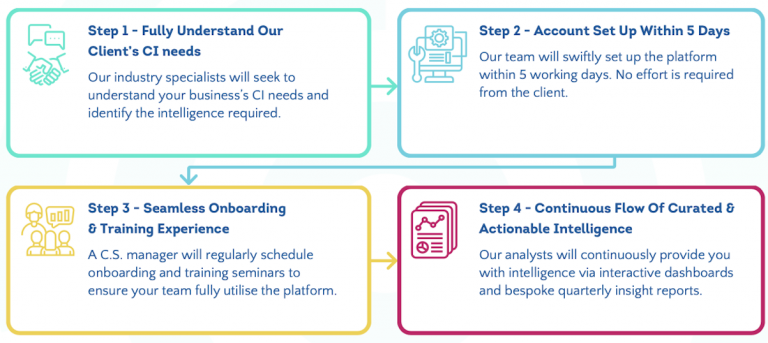Summary
- Competitive intelligence software tools enable companies gather, analyse and utilise data about competitors and their industry.
- In recent years competition for revenue and market has grown more intense in the finance industry.
- Competitive intelligence (CI) can help financial service companies make informed and effective decisions.
- There’s 3 key factors when it comes to making full use of CI and competitive intelligence software tools in the finance sector.
Introduction
Whether you’re in banking, insurance, mortgage lending, car leasing or another financial institution, competition for revenue and market share is intense. This is particularly the case for the more profitable sub-sectors, with Goldman Sachs estimating that nearly $5 trillion of global industry revenue earned by traditional firms is at risk of being diverted to the new generation of fintech companies over the coming years.
Moreover, there has been a noticeable transformation in financial institutions’ interaction with customers. Take for example an independent survey of 251 key finance sector decision-makers, which shows that over 70% of them are developing and launching products to keep pace with consumers’ evolving demands.
Every move they make affects you. If they have a stronger proposition, a better service, a more attractive price, respond faster to regulatory changes or they communicate better, holding or improving your position becomes harder and harder to do.

In this environment, a loss of market share could be worth billions. It can mean lost jobs, reduced budgets and tougher day-to-day challenges. It can make it harder to recover and return to previous levels of success. And it could even make you even more vulnerable to challenger brands.
The most effective means to minimise the impact of competitor activity is to know what’s happening early on, and to have a clear overall picture of the market, that enables you to be proactive with your own decisions and product roadmaps. That’s why many financial organisations are investing in competitive intelligence – competitor and market insights gathered through tracking and analysis.
In this article, we’ll explore competitive intelligence software tools and the role of CI in the finance sector.
We’ll look at the value it offers, how organisations might be approaching it in an ineffective manner, and how your business can harness CI to stay ahead of new and established competitors.
What Are Competitive Intelligence Software Tools
A competitive intelligence software tool is a specialized software application designed to help businesses gather, analyze, and utilize information about their competitors, market trends, and industry dynamics. These tools enable organizations to make more informed decisions and develop effective strategies to gain a competitive edge in their market.
Features of competitive intelligence software tools
Data gathering: The software collects data from various sources, such as competitors’ websites, social media, news articles, and industry reports. This information is then organized and stored in a centralized database for further analysis.
Data analysis: The tool offers various analytical features to identify patterns, trends, and insights in the collected data. It may include benchmarking, sentiment analysis, and visualization tools to help users better understand the competitive landscape.
Monitoring: The software tracks changes in competitors’ activities, market trends, and industry news in real-time, providing users with up-to-date information.
Reporting: The tool generates reports and dashboards that summarize the competitive analysis, highlighting key findings and actionable insights for decision-makers.
Collaboration: The software allows teams to collaborate and share information, ensuring that everyone in the organization is working with the same data and insights.
What Is The Purpose Of Competitive Intelligence In Finance?
Tracking competitor and market activity is nothing new for financial organisations. Chances are you’re already doing it in some capacity, even if it’s using manual processes or multiple monitoring tools, such as Google Alerts, Brandwatch and SEMRush.
And if that’s the case, you may have found these approaches slow and frustrating with inconclusive results. Key insights – and therefore opportunities – can be easily to missed, especially if there’s insufficient employees involved.
That shouldn’t put you off using competitive intelligence though. With the right tools, competitive intelligence gives finance organisations faster access to richer, more comprehensive competitor and market insights. It can, for example, help you to gauge the following factors:
- Competitors’ wider pricing and product strategies in different markets.
- Latest overall industry developments, such as delays due to regional exogenous shocks or political developments.
- Regulatory issues within specific jurisdictions.
- The key messages competitors are sending to existing or potential clients in different markets.
- Expansion or exit plans for specific markets via public recruitment or news of layoffs.
- Identify potential M&A targets or partners, assessing their value, and determining the potential risks and benefits with the deal.
Competitive intelligence can help you devise smarter, more robust strategies and product roadmaps and set your price points knowing how they compare in the market.
Ultimately, it takes away the guesswork and reduces commercial risks, which is vital for the health of your organisation.
So how do you make full use of competitive intelligence? Here’s our guide to getting it right.

Effective Use Of Competitive Intelligence In Finance
When it comes to making full use of competitive intelligence, there are 3 important steps to take into consideration:
1) Defining Your CI Strategy
Like any investment you need to define your objectives and reasoning before you commit company resources.
We outlined the value of competitive intelligence in the previous section, which may align with your own challenges and goals. Whatever they are, they’re your starting point for building a successful CI strategy. Once you’re clear, you can use those goals to identify who and what to track.
For example, which other financial institutions are you in direct competition with – either overall or for specific products? Who do you compete with indirectly? Are there any banks or lenders in other countries with similar product propositions or up-and-coming organisations with different ranges of products and services that are worth following?
But it’s not just competitors. You can also track industry publications, regulators and governing bodies, consumer groups, review sites and more. Now you’ve identified who you’re tracking, you can move to what to track.
Here’s a list of examples based on our experience of working with major financial institutions, ranging from banks to insurance firms:
Pricing – Who offers the best rates or yield for specific financial products in the market? How do they compare with your products? How is it impacting their financial performance and yours?
Performance – Who’s leading the market in terms of financial performance or industry recognition (e.g. awards or third-party backing)? Who’s up-and-coming? Who’s falling away? Where does your organisation sit?
Product – What’s been launched, updated or removed in specific markets? What factors led to the change? Have they created a new category or innovated in an existing one? How do competitor products compare to yours?
Messaging – Who’s changed their messaging? Have they switched focus? Has ESG become more prominent? Is it price-driven? What does it tell you about their strategy and future plans?
Campaigns – Who’s launched a new campaign? What’s its focus? What media channel is being used? Who are they targeting? Are they generating a buzz on social media or in the news? What impact is it having?
Regulatory changes – What changes are being planned in different jurisdictions? Is there a wider trend and how can you prepare effectively? Can you position yourselves as a leader when it comes to adapting?
Organisational leadership changes – Which of your competitors have been hiring recently? What’s their track record? What impact could it have on the company or department’s direction? Has one of your competitors lost a top performer and if so what are the implications?
This gives you an indication of what you can learn and capture through competitive intelligence. Imagine what impact these insights would have on your decision-making, in your analysis or future planning.
2) Choosing The Right Competitive Intelligence Software Tools
There’s currently a wide range of competitive intelligence software tools on the market. Some that offer a more comprehensive range of data, others that are focused on specific aspects of competitive intelligence. Here are some of the most important factors to consider when choosing competitive intelligence software tools:
a) Does it track data in real-time?
Not all do and it can leave you handling intelligence that’s days or even weeks old by the time it’s in your dashboard. Automated real-time reporting means getting faster access to intelligence and having the confidence of knowing your decision-making is backed up with up-to-date data.
b) How quick and easy is it to set up?
Speed matters because while you don’t have a competitive intelligence software tool running, you could be making decisions without the aid of valuable insights. But simplicity is important too.
You’re financial experts with important day jobs – the last thing you need is to waste time trying to understand how to use your CI tool. To get the most out of your investment, choose a tool that makes setting up quick and easy.
c) Does the customer support continue?
Some tools offer sector-specific analysts who’ll take your strategy and do the set up on your behalf. Having analysts help you with the set up is great but is the last you see or hear from them? The best CI software teams make themselves available to ask questions, make updates to your CI programme and even help you analyse the data that’s being gathered.
d) How easy to use is the dashboard?
Your CI dashboard is your hub – your centralised repository for competitor and market intelligence. The longer you use it, the more historical data you’ll hold, which can help you identify trends and patterns of activity. But it’s also where you’ll access real-time competitive intelligence. Whatever you need access to needs to be easy to find, export and share.
e) Does it make it easy to share and report on?
As useful as competitive intelligence might be to the person who’s managing the dashboard, it can offer even more value by being distributed to other people and departments in the organisation. For example, as well as finance and analytical departments, it could help marketing to transform the effectiveness of their campaigns.
So look for a competitive intelligence software tool that offers simple integration with your existing communication and data visualisation software. Ideally, you want the ability to automate this process to save you more time and effort, as well as having the ability to flag specific alerts for the attention of relevant stakeholders.

3. Integrating Competitive Intelligence Software Tools Into Your Organisation
It’s not enough to just put competitive intelligence into the hands of the a small team or department. To maximise your return on investment, you need to mobilise your organisation to utilise it effectively and consistently. Here are 3 areas to focus on:
a) Responsibility
Who receives the alerts and who’s ultimately responsible for acting upon it? While your competitive intelligence will help everyone with access to make smarter decisions, it’s important that those receiving the alerts know there’s an expectation to use it. Designating roles and expectations from the outset will stop data falling into a black hole.
b) Processes
Who receives the alerts and who’s ultimately responsible for acting upon it? While your competitive intelligence will help everyone with access to make smarter decisions, it’s important that those receiving the alerts know there’s an expectation to use it. Designating roles and expectations from the outset will stop data falling into a black hole.
c) Measurement
While a number of different factors can affect your performance, identifying the correlation between competitive intelligence-informed actions and the results you achieve is key to understanding and assessing its value. It could be a case of measuring the cost avoidance of stopping a new product to gain an early advantage in the market or the impact of an intelligence-driven strategy. ROI or at least KPIs will also provide you with the business case to invest further in competitive intelligence.
Make Smarter Decisions Faster With WatchMyCompetitor

Unlike other intelligence solutions that serve up hard-to-mine unfiltered data, or which collate insights into periodic reports that lack immediacy, WatchMyCompetitor is the complete competitor intelligence platform.
We use AI to track your competitors’ global digital footprint in real time, so you don’t miss anything important. While our market experts analyse and curate the most relevant competitive insights on your behalf.
That means no more sifting through unmanageable volumes of data. You get fast access to relevant, timely intelligence to optimise strategies, outsmart the competition and protect and grow your revenue.
Don’t let your competitors gain an advantage. Book a demo today.

